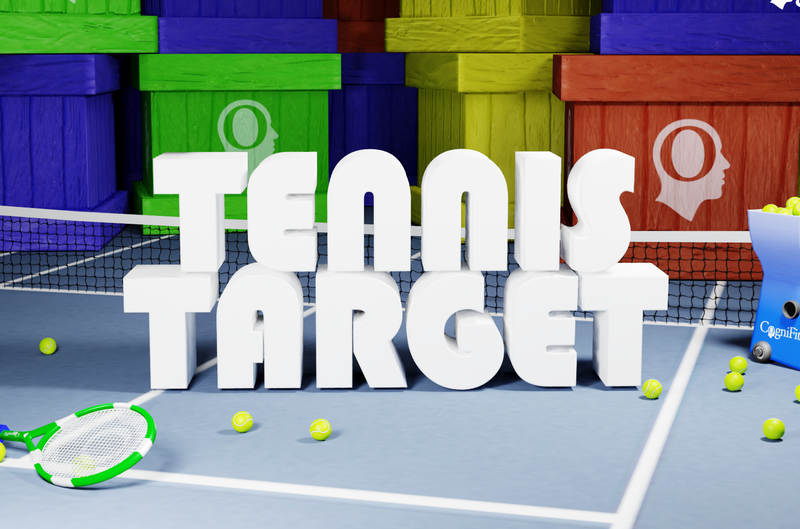
Tennis Target – How Good Is Your Inhibition?
Tennis Target is one of three tennis-theme games in CogniFit’s brain game collection. But how is it different from its counterparts?
First, its gameplay is entirely different. Also, it exercises different cognitive functions – Estimation, Inhibition, and Response time. Let’s take a closer look at each of these as well as how to play.
How to Play Tennis Target
As with all CogniFit’s tennis games, you’ll have your own side of the court.
But instead of being able to move around a 3D space, you’ll only be able to tilt the racquet up and down as well as rotate it. This is done by using the up/down/left/right arrow keys. Each time you press an arrow key the glowing target will highlight a different section of the opposite side of the court.
A ball launcher will shoot a tennis ball at you (at regular intervals) and you have to carefully time when the ball gets shot, when it hits your racquet, and when it will hit the moving targets (in this case, colorful crates).
These targets will either have a picture on the front or nothing at all. Each of the pictures has a different function…
- CogniFit Logo – These are the boxes you really want to hit to progress to high/harder levels
- Three Dots – These replenish your tennis balls (because you’ll only be given a limited amount)
- Flame – This one will explode the adjacent boxes, making it easier to clear crates without using up valuable ammo.
- Star – These will give you more points and help you progress faster
Sounds simple enough, right? Just time your hits to make contact with the boxes.
Well, it wouldn’t be a CogniFit game without higher levels being incredibly difficult.
The harder the level, the more crates you’ll have. This doesn’t only include how many are stacked on each other, but how man stacks are taking up the opposite side of the court. And, they will keep rotating (obviously faster), making it harder to hit the target. Plus, there is a gauge on the right side of the screen. You can only fire a ball when the moving gauge is in the highlighted area.

It won’t take long for you to see how Tennis Target is different from the other tennis games. Also, how it works specific cognitive functions. Let’s look at each one you’ll be using…
Estimation
This is a very important neuropsychological function. This is because so many of our daily activities need us to estimate things like…
- Distance: Distance estimation is the ability to estimate the future location of an object based on its current distance, and is the ability that makes it possible for us to carry out everyday activities without bumping into people or things.
- Speed: Speed estimation is the ability to estimate the future location of an object based on its current speed. This is what makes it possible to move through life and avoid obstacles and accidents.
- Movement: The ability to anticipate an object’s movement.
- Time: The ability to calculate the amount of time there is between two events.
Driving is a perfect example. Just think of having to change lanes. You have to see all the cars around you and estimate many things before you can safely move. Another good example is sports – we can’t play anything without Estimation abilities. But it can also be used in something as simple as shopping or moving around other people.
In Tennis Target, you’ll have to estimate the time it takes between the ball launch to when it will hit the moving boxes.
Inhibition
This ability isn’t one that most people think of when it comes to cognitive functions. However, it’s just as important as its brothers and sisters.
Essentially, it’s our ability to control impulsive or automatic behavior. It’s also one of our Executive Functions, which contributes to anticipation, planning, and goal setting. Good Inhibition allows you to do many things…
- Concentrate without getting distracted easily
- Exercise control while driving
- Not dwell on negative thoughts for too long
- Resist bad habits or actions (like scratching a bug bite)
- Have a conversation with good flow and fewer interruptions
- Not losing your temper too quickly
In Tennis Target, the limited ammo (and firing gauge on harder levels) forces you to be more careful with your actions and really pushes your Inhibition.

Response Time
Also known as Reaction Time, this is the time that takes from when we perceive/see something to when we respond to it. It also depends on different factors…
- Perception: Seeing, hearing, or feeling a stimulus with certainty is essential to having good reaction time. When the starter shoots the gun at the beginning of a race, the sound is received by the athlete’s ears.
- Processing: It’s necessary to be focused and understand the information well. The runners, after hearing the gun, will be able to distinguish the sound from other background noise and know that it is time to start running.
- Response: Motor agility is necessary in order to be able to act and have good response time. When the runners perceived and correctly processes the signal, they started moving their legs.
It also depends on how complex the stimulus is, how familiar it is, how aware or awake (even healthy) the person is, and which of the senses gets the information. For example, auditory information is processed faster than visual.
Tennis Target’s moving boxes and timed ball launches are key to honing good Reaction Time.
Tennis Target Conclusion
When it comes to cognitive exercises, you don’t need to dedicate as much time as you think. All you need is 3 sessions a week and 20 minutes per session. Try out this game along with Tennis Bomb and Tennis Bowling for a more complete, and fun, workout.
Disclaimer: CogniFit’s cognitive training and assessment tools are designed to promote cognitive stimulation and mental engagement. They are not intended to diagnose, treat, or prevent any medical condition. All information presented here is for educational and informational purposes only and should not replace professional healthcare advice.
The information in this article is provided for informational purposes only and is not medical advice. For medical advice, please consult your doctor.














